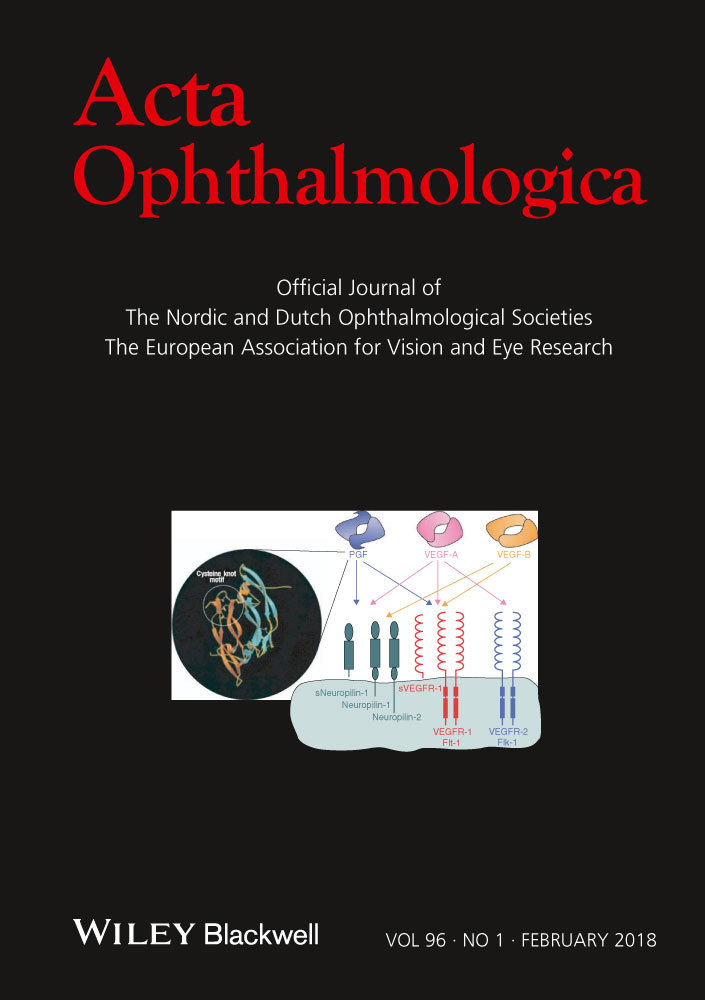This issue of ACTA
This issue of ACTA, printed and electronic, February 2018
Cover photograph
The cover illustration demonstrates receptors for placental growth factor and vascular endothelial growth factor A and B in a schematic fashion. This comes from the review article by Nguyen in the electronic part of this issue of ACTA.
Editorial
Franz Grehn in Würzburg, Germany, discusses congenital glaucoma surgery in the light of an article by El Sayed et al. on microcatheter-assisted trabeculotomy in paediatric glaucoma published in the December issue of ACTA.
Review articles
Askou et al. in Århus discuss microRNA, its possible role in age-related macular degeneration as well as new targets for gene therapy in the eye.
Glaucoma
Tan et al. in the Netherlands conclude that the Baerveldt implant is a safe and effective treatment of uveitic glaucoma.
Oncology
Staby et al. in Bergen and Copenhagen describe molecular gene markers that predict metastases in uveal melanoma.
Jacobsen et al. in Copenhagen describe visual improvement following surgery for craniopharyngioma.
Myopia
Fledelius et al. in Denmark measured choroidal thickness in a high myopia cohort followed for four decades.
Paediatric ophthalmology
Magnusson et al. in Sweden and Denmark found the prevalence of congenital cataract in infants to be 30 per 100 000 about 50% are operated in the first year of life and most receive an intraocular lens.
Retina
Ten Berge et al. in the Netherlands found antiretinal antibodies in more than half of patients with central serous chorioretinopathy.
van der Heijden et al. in the Netherlands and the USA validated an automatic image analysis system for diabetic retinopathy screening.
Cornea
Dua et al. in the UK and Egypt examine the movement of air in the cornea in simulated deep anterior lamellar keratoplasty (DALK).
Lacrimal system
Bohman et al. in Sweden validated the Catquest-9SF questionnaire to measure visual disability in patients with epiphora.
Cataract
Makhotkina et al. in the Netherlands found that many patients experience dysphotopsia after cataract surgery, but only report this when asked.
Weingessel et al. in Vienna examined visual and social factors that influence how patient people are to wait for cataract surgery.
Mattila et al. in Finland associated high serum ferritin levels with cataract formation.
Retina
Rishi et al. in India describe retinal tears resulting from infusion flow in 25 gauge vitrectomy.
ELECTRONIC PUBLICATIONS
The following articles are published only in the electronic part of this issue and are accessible on www.actaophthalmologica.com.
Review article
Nguyen et al. in USA, Italy, France, Canada, China and Germany summarize the current knowledge of placental growth factor, its relationship to vascular endothelial growth factor and role in pathological angiogenesis in retinal diseases.
Retina
Hattenbach et al. in Germany found greater visual acuity gains with ranibizumab than dexamethasone implants in patients with branch retinal vein occlusion and macular oedema.
Beltramo et al. in Italy and Spain examined pericyte apoptosis in tissue culture.
El-Asrar et al. in Saudi Arabia and Belgium suggest that metalloproteinases may be possible biomarkers in diabetic retinopathy.
Chan et al. in Hong Kong and UK examine silicone emulsification and how it may be removed during vitreous surgery.
Ho et al. in Taiwan recommend modified inverted limited membrane flap for macular hole detachment in myopic eyes.
Lee et al. in Singapore and Hong Kong describe reduced signal strength with spectral-domain OCT to be associated with older age, poorer vision, myopia and cataract.
Koyanagi et al. in Japan found attenuated parafoveal microvasculature in retinitis pigmentosa, which correlates with reduced central visual function.
Glaucoma
Stodtmeister et al. in Dresden found retinal venous pressure to rise more than the intraocular pressure during Valsalva manoeuvre.
Seuthe et al. in Germany recommend canaloplasty with suprachoroidal drainage during cataract surgery in patients with glaucoma.
Cornea
Parekh et al. in Italy and Saudi Arabia and France used recombinant human serum albumin in synthetic organ culture for corneal donors.
Dudakova et al. in Czech Republic, Belgium and USA describe genetic mutations in four families with cornea plana.
Letters to the editor
Uparkar et al. in India comment on the article by Merry on photobiomodulation in AMD in a recent issue of ACTA.
Hamoudi et al. in Copenhagen found insignificant changes in refraction following pars plana vitrectomy.
Grzybowsky and Patryn in Poland review corneal transplants in Poland.
Gharehbagh in Denmark describes transient but not long-term vision improvement with aflibercept treatment for polypoidal choroidal vasculopathy in Caucasians.
Malerbi et al. in Brazil associate microalbuminuria and choroidal thickness in patients with diabetes.
Nowak et al. in Poland associate neurodegeneration-related proteins with the risk of glaucoma.
Arribas-Pardo et al. in Spain found no change in intraocular pressure with intrastromal corneal ring implantation.
Bhikhie et al. in Suriname and the Netherlands found toxoplasmosis to be the most common cause of uveitis in Suriname.
Mendes et al. in Portugal used intravenous abciximab, which prevents platelet aggregation, as treatment of acute central retinal artery occlusion.
Cennamo et al. in Italy find some usefulness in autofluorescence in diagnosing choroidal nevi and melanoma.
I hope that this issue of ACTA finds you in good health and spirits and that the journal will help you advance patient care and ophthalmic science.




